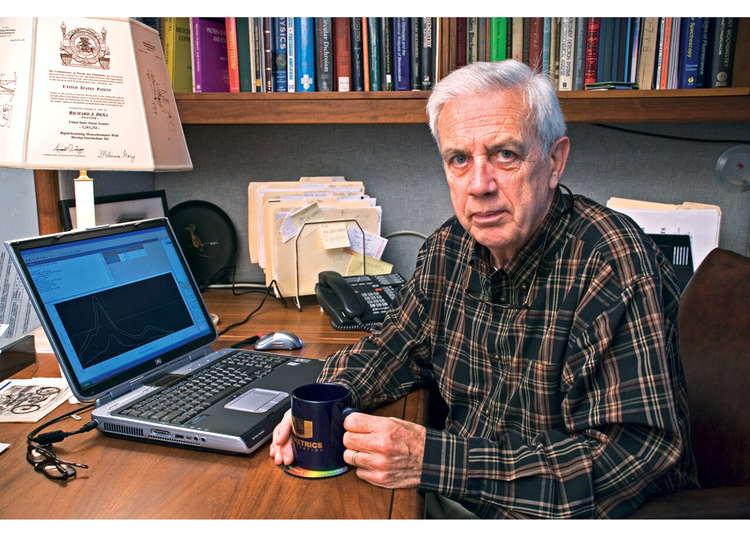The Definitive Guide to Spectrophotometers
The Definitive Guide to Spectrophotometers
Blog Article
Some Known Factual Statements About Circular Dichroism
Table of ContentsAn Unbiased View of Uv/vis3 Simple Techniques For Circularly Polarized LuminescenceLittle Known Questions About Uv/vis.The Greatest Guide To Circular DichroismWhat Does Circularly Polarized Luminescence Mean?

Spectrophotometry is a tool that hinges on the quantitative analysis of molecules depending on how much light is absorbed by colored compounds.
Some Known Details About Uv/vis
A spectrophotometer is commonly utilized for the measurement of transmittance or reflectance of services, transparent or nontransparent solids, such as polished glass, or gases. Numerous biochemicals are colored, as in, they soak up visible light and for that reason can be determined by colorimetric procedures, even colorless biochemicals can frequently be converted to colored substances appropriate for chromogenic color-forming responses to yield substances ideal for colorimetric analysis.: 65 However, they can likewise be created to measure the diffusivity on any of the listed light ranges that generally cover around 2002500 nm utilizing different controls and calibrations.
An example of an experiment in which spectrophotometry is utilized is the decision of the balance constant of an option. A specific chemical response within a service may happen in a forward and reverse direction, where reactants form items and items break down into reactants. At some point, this chain reaction will reach a point of balance called an equilibrium point.
A Biased View of Uv/vis
The amount of light that travels through the option is a sign of the concentration of specific chemicals that do not allow light to pass through. The absorption of light is because of the interaction of light with the electronic and vibrational modes of molecules. Each kind of molecule has an individual set of energy levels associated with the makeup of its chemical bonds and nuclei and hence will take in light of particular wavelengths, or energies, resulting in special spectral homes.
They are commonly utilized in numerous markets including semiconductors, laser and optical manufacturing, printing and forensic assessment, as well as in laboratories for the research study of chemical substances. Spectrophotometry is typically utilized in measurements of enzyme activities, determinations of protein concentrations, determinations of enzymatic kinetic constants, and measurements of ligand binding reactions.: 65 Ultimately, a spectrophotometer is able to figure out, depending on the control or calibration, what compounds are present in a target and exactly how much through computations of observed wavelengths.
This would come as an option to the previously created spectrophotometers which were not able to soak up the ultraviolet correctly.
Examine This Report on Circularly Polarized Luminescence
It would be discovered that this did not provide satisfactory outcomes, for that reason in Model B, there was a shift from a glass to a quartz prism which permitted much better absorbance outcomes - spectrophotometers (http://www.cartapacio.edu.ar/ojs/index.php/iyd/comment/view/1414/0/30215). From there, Model C was born with an adjustment to the wavelength resolution which wound up having 3 units of it produced
It was produced from 1941 to 1976 where the rate for it in 1941 was US$723 (far-UV devices were an option at additional expense). In the words of Nobel chemistry laureate Bruce Merrifield, it was "probably the most essential instrument ever established towards the advancement of bioscience." Once it became stopped in 1976, Hewlett-Packard developed the first commercially available diode-array spectrophotometer in 1979 called the HP 8450A. It irradiates the sample with polychromatic light which the sample soaks up depending on its residential or commercial properties. It is transferred back by grating the photodiode selection which identifies the wavelength region of the spectrum. Considering that then, the creation and execution of spectrophotometry gadgets has increased immensely and has turned into one of the most ingenious instruments of our time.

The Basic Principles Of Circular Dichroism
Historically, spectrophotometers use a monochromator consisting of a diffraction grating to produce the analytical spectrum. The grating can either be movable or fixed. If a single detector, such as a photomultiplier tube or photodiode is used, the grating can be scanned step-by-step (scanning spectrophotometer) so that the detector can determine the light strength at each wavelength (which will correspond to Recommended Reading each "action").
In such systems, the grating is repaired and the intensity of each wavelength of light is determined by a various detector in the range. When making transmission measurements, the spectrophotometer quantitatively compares the portion of light that passes through a reference option and a test solution, then digitally compares the strengths of the 2 signals and computes the portion of transmission of the sample compared to the recommendation standard.

Report this page